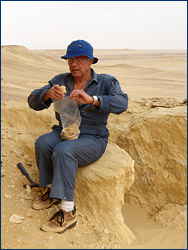
Dr. Amin Marco Strougo, of Ain Shams University in Cairo, collecting rock samples. *Click on any photo on this page to see an enlargement.
Pyramids, forams, and Red Sea reefs: Field notes from Lorraine Casazza
By UCMP grad student Lorraine Casazza, November 17–20, 2007
| Lorraine came to Egypt on a Fulbright Fellowship to work on a coral reef monitoring method using foraminifera, and has been granted a six-month extension to continue her work. Lorraine believes that the decline of coral reefs is a global problem that requires global solutions. Through international collaboration, scientists have the ability to bring cultures, and nations, together. |
November 17, 2007
 Dr. Amin Marco Strougo, of Ain Shams University in Cairo, collecting rock samples. *Click on any photo on this page to see an enlargement. |
There are also countless nummulite tests, the giant, single-celled organisms whose symbiotic relationship with photosynthetic algae interests me so much. The rocks in Wadi Al-Hitan capture an interesting transition in the evolutionary story of Nummulites, and I'll have the chance to sample across a time when the largest members of the group disappear and give way to their much smaller relatives.
I had the opportunity to visit Wadi Al-Hitan last year as a tourist, but this time I'll be visiting as a researcher, which is much more exciting. Dr. Strougo will be meeting up with a team of scientists who are mapping the geology of the Valley and searching for new fossils. As a graduate student new to this study area, I'll be a beneficiary of their expertise as I collect my nummulite samples.
November 18, 2007
A drive through time
We begin our drive in the present — that is, in hellish Cairo traffic. Our driver tries to nudge forward between lanes of idle cars, but we still spend the better part of three hours at a dead stop, breathing in the noxious exhaust fumes of the mini-bus ahead of us. Dr. Strougo tries to break up the monotony by stopping off at a ta'maya stand on the way. Ta'maya is just the Cairo name for falafel, the little fried balls of ground chickpea widely available at Middle Eastern restaurants in the U.S. For a few minutes we feel revived as we discuss the merits of local cuisine, but the crushing boredom of traffic eventually descends over us, and we stare out of our respective windows.
It's mid-afternoon by the time we escape the congestion of one of the world's largest "megalopolises" (nearly 30 million people, and counting) and follow the open road south through the Nile Valley. The landscape changes to green fields, and the dilapidated black-and-white taxis of the city give way to farmers driving donkey carts. For someone like me, used to the technological wonderland of urban America, the peaceful, rural life of the valley is like a glimpse into the past.
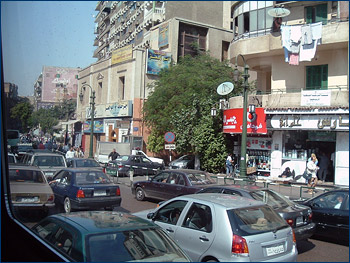 |
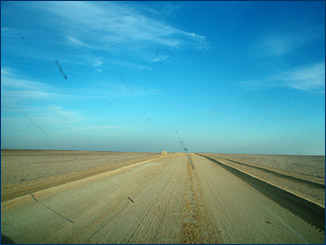 |
|
| Left: Gridlock in downtown Cairo. Contrast this with … Right: The flat and featureless Western Desert (west of the Nile but at the eastern end of the Sahara). | ||
Egypt is sometimes called "a gift of the Nile," and the evidence for this sentiment is obvious as we turn away from the valley to head out into the surrounding landscape. About 96% of Egypt is desert, and life clings to the banks of the Nile. Although new desert-reclamation projects are underway now, historically only the nomadic Bedouin tribes could survive the vast, empty heat of the deserts. There are some plants and animals specially adapted to this severe habitat — like a snail that buries itself for years at a time in the dry river beds (wadis) of the eastern desert, only to remobilize when a good rain falls (so cool!) — but the casual visitor is unlikely to see many, if any of them. Looking out over the terrain, I can't decide if it looks more like the moon or Antarctica — the white sands stretching all the way to the horizon like ancient snow.
We pass by the man-made lakes of Wadi El-Rayan — both getting smaller and saltier every year — and then nothing but desert lay before us. It's called the Western Desert in Egypt because it lies to the west of the Nile, but it's also the eastern reach of the great Sahara Desert, which spans all of North Africa from the Red Sea to the Atlantic. It covers an area of 3,500,000 square miles — nearly the size of the United States. It's difficult to imagine so much emptiness, even when you're in it.
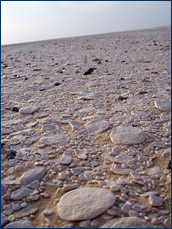 |
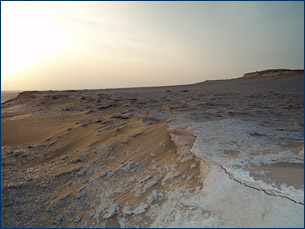 |
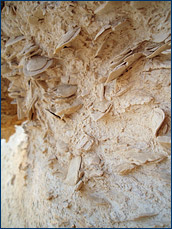 |
| Left: At the first stop, the entire desert floor is comprised of Nummulites. Center: A middle Eocene outcrop — the youngest visited on the field trip and full of giant Nummulites. Right: The weathered face of the outcrop, with Nummulites galore. This surface will be knocked off with a hammer and chisel, and a sample will be taken of the "fresh" rock behind it. | ||
Dr. Strougo, who has a keen interest in echinoids, (the group that includes things like sand dollars, starfish, and sea urchins) has collected a sack full of fossil sand dollars. We stand at the top of the outcrop and compare our loot as the sun slips closer to the western horizon. We talk about the local stratigraphy — or rather Dr. Strougo talks and I ask questions.
The rocks here were originally deposited in the warm, shallow coastal waters at the southern edge of the Tethys Sea from about 48 to 33 million years ago. Since then, movements of the Earth's crust have caused them to be tilted ever so slightly, so that as we travel roughly north, we will also be traveling from older to younger rock beds.
Today we've traveled from the modern hustle of Cairo all the way back to an ancient sea floor. For the next two days, we'll slowly be working our way forward again through the Eocene rocks that tell the story of a long lost time and place.
The camp
We make it to camp just in time for dinner, which is a pretty typical Egyptian spread: rice, bread, tahina (a runny, sesame paste) and some vegetables in sauce. We arrange ourselves on bunks and the floor around a table in one of the rooms. David, a micropaleontologist from the UK with a lot of experience working in Egypt, spends the meal telling me about a book called The Nummulosphere. It was written in the early 20th century by a British scientist who had done significant work on sponges and corals, but ruined his reputation by publishing this strange book. In it, he claims all the rocks in the world formed from the accumulation of foraminifera like Nummulites. David hints that the poor author may have gone insane spending too much time looking at his Nummulites. It feels like a cautionary tale ….
The few rooms available are all full, so Dr. Strougo and I go out to set up tents for ourselves. I'm a pretty enthusiastic camper at home, so I'm excited to be sleeping out under the desert sky. I even tromp off into the desert valley to get away from the lights and the sound of the generator. There isn't much of a moon, but I make my way toward a big rock sitting below a ridge. The desert floor is covered in bits of pointy rock, broken seashells, bone fragments and jagged Nummulites, so I'm pleased when I find a small depression full of fine soft sand to make my home.
 |
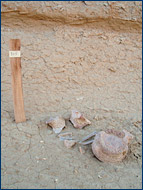 |
 |
| Left: Home sweet home. Center: The fossil remains of an archaeocete. It's been mapped and assigned a number. Right: Morning at the field camp. | ||
The sandstorm
Some time around midnight, I wake up thinking I'm being assaulted with a sandblaster. Tiny particles sting my face and arms as I try to zip up the netting on the front of my wildly flapping tent. The wind rips the tent-stakes out of the ground, and for a minute I think I'm going to blow away with the whole thing. Thankfully my rock samples keep us all anchored.
For the next 15 minutes I curse and squint and spit sand as I try to re-secure my tent with my eyes closed, because I'm afraid they'll be scoured out of my head if I open them. I never appreciated how much being down in the river valley protects Cairo from the full fury of desert windstorms. It's like a hurricane full of sand. It's pure evil.
I find some big chunks of nummulitic rock to tie my tent lines too — Nummulites to the rescue! I seal up the tent as well as I can, but I still have to wrap my head in a t-shirt to keep the sand from taking off the top layer of skin. Somehow, I eventually sleep.
November 19, 2007
The transitional beds
The morning sky is beautiful and clear, and the sand is where it belongs — on the ground. As I brush my teeth, I wander around and find what I suspect is an archaeocete vertebra that has already been mapped, and marked with a numbered stake. I also find a shark tooth, which I keep.
There are two working pick-up trucks at the camp, each with a designated driver — and with good reason. Desert driving requires a great deal of skill and knowledge of the terrain. It's easy to get stuck in the sand, or worse, disoriented and lost. One of the other researchers tells me that even experienced drivers have gotten confused out in the desert and never come back.
Dr. Strougo and I will be going with another researcher in one truck to look at a bed where the last of the giant Nummulites appear. You can actually walk up the side of the outcrop and see how they dwindle away, becoming less and less abundant in the rocks, replaced by another kind of foraminifera called Discocyclina. Dr. Strougo will be collecting his own geologic samples for the mapping of the area.
We work from about 7:30 a.m. when we reach the outcrop, until mid-afternoon. Except for a short lunch break it's pretty much non-stop note taking, picture taking, and hammering out samples. Then we drive to an area called the Side Valley. Here, the rocks are from the Upper or Late Eocene, meaning younger than the ones we've been looking at. Here, I find the small nummulite species that fully replaced their truly giant predecessors. Looking down at the lentil-sized specimen, I realize that an era has ended for the Nummulites. Never again in their evolution did they achieve the diversity, the size … the grandeur, that they left behind in the Middle Eocene. What happened?
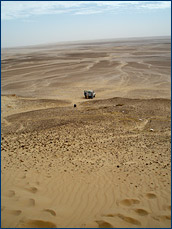 |
 |
 |
| Left: Looking down the outcrop, which is like looking back through time (older rocks at the bottom, younger rocks up top). The backpack (click the photo for an enlargement) marks the last appearance of the largest Nummulites. The small white bags marching up the outcrop show where rock samples were taken for later processing. Center: The only wildlife sighted on the trip — a four-inch long Egyptian Grasshopper (Anacridium aegyptium). Right: Lunch was generously provided by the field camp staff: bread, gibna (a local white cheese), cucumber, tomato and oranges. The glistening blobs are jelly. | ||
At the end of the day, we sit near the truck to relax for a minute. Dr. Strougo has found some more interesting echinoids, and he's wrapping them in toilet paper and stuffing them into matchboxes so they don't break (they're quite fragile). Our other colleague thinks he may have found another whale fossil, and he's excited to tell the others about it so that they can come and do some digging tomorrow. All in all, it's been a successful day.
All that's left to do is move my tent behind a rock so that I don't get blown off the face of the planet again tonight.
November 20, 2007
The "small" Nummulites
I wake up early with the rest of the camp, but my sampling will be done around the field station today, and so I see everyone else off in the trucks. One of the rangers, Mohamed Sami, comes with me. I met him last year when I was visiting with a tour group, and it turns out he lives here all year round. Lucky guy!
We hike around the valley, starting with a bed that until recently, everyone thought was the fossil remains of a mangrove forest. Some German scientists have taken another look, however, and they claim that they aren't mangrove roots, they're clam burrows. Whatever they are, Nummulites liked living around them.
|
|||||||||
We make our way up onto the cliff where there are the fossil remains of huge, incredible burrows filled in with yet more Nummulites. Once I collect my samples, we spend the rest of the afternoon walking higher up the outcrop, moving forward in time. The ranger helps me identify some of the fossils we find — the giant oyster Pycodonta and casts of Turritella (a kind of gastropod, or snail). He also shows me a complete archaeocete skeleton that's still trapped inside the cliff.
The day slips by quickly, and I have to hurry up to the visitor's center to meet the car coming to pick me up. My driver thinks we're going straight back to Cairo, but I make him stop twice along the dirt road back to civilization so that I can take a few more notes and collect a few more loose specimens. I'd like to stay longer, but I'm leaving for a longer field trip in two days out to the Red Sea coast. I'll be leaving the mysteries of Nummulites for a while and focusing instead on the fossil coral reefs. It's going to be great!
All photos by Lorraine Casazza.